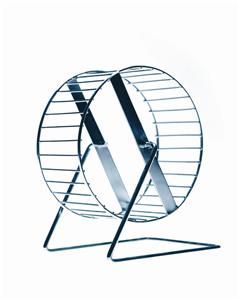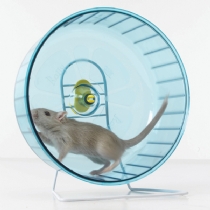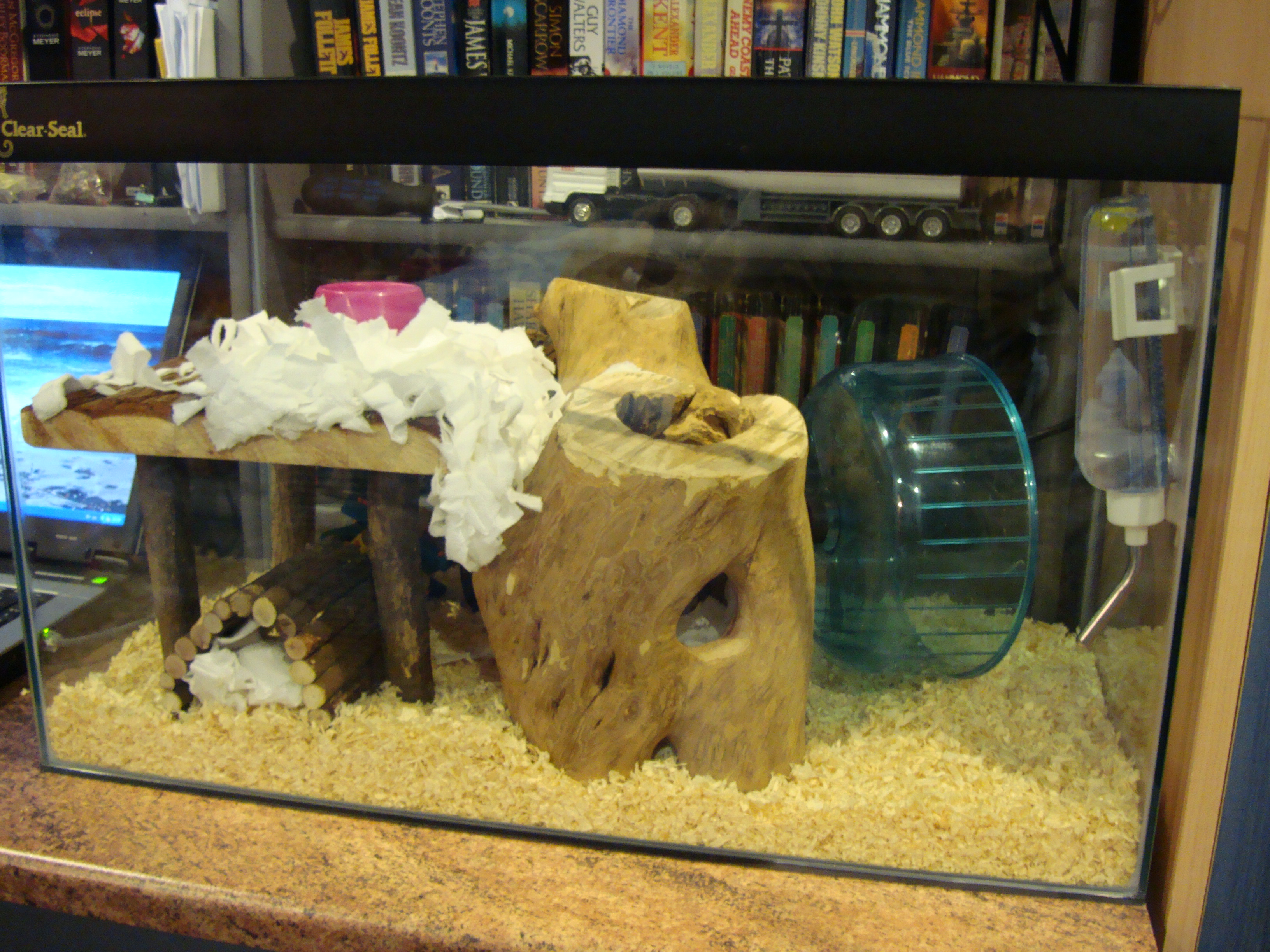As with Biscuit, Charlie is a prolific cage bar-chewer.
Before I tell you how we're solving this problem, a little information about Hamster Keeping.
There are many varieties of hamster. The main ones are Syrian hamsters, the largest hamster breed, and dwarf hamsters, including Chinese and Russian hamsters, amongst others, which are much smaller. I don't know much about the dwarf hamsters, so this information will mostly be related to Syrians.
A burrowing animal by nature, hamsters like tunnels - however, many of the cages with tunnels on the market are much too narrow for a fully grown Syrian hamster. This is also true for cages - the bigger the better, though many shops with hamster "starter" kits sell a tiny cage, with a tiny wheel, with tiny tunnels, which your Syrian hamster will very quickly grow out of. The cage we bought originally for Biscuit is 16"x14"x12", and came with tunnels that locked into the shelves - Biscuit, roughly a year old when we adopted her, was already too big for these tunnels. Charlie fitted through them fine when we adopted him at 4months old, now, at 5 1/2 months, he really struggles to get through easily. I'll take this opportunity to point out that neither of our hamsters have been overweight, or even close! We've always been on the lookout for a larger cage, but so far haven't found one that's much bigger.
Hamsters are designed for running and foraging. While they may look an ungainly creature (especially after keeping more agile rats as pets) they are very good at running for long periods of time, and in the wild can cover many kilometres in a single night. This is why a wheel in a hamster's cage is so important. Once again, many of the wheels sold in shops are unsuitable for hamsters in that they are much, much too small. A hamster shouldn't have to bend his/her back to get into the wheel - it should be as though they're running normally along the ground. The wheel should also be flat, not with rungs that small feet could get caught in, and semi - contained from one side - again, to prevent limbs getting caught and broken by non-moving parts. Charlie and Biscuit have both so far used a Savic Rolly Large, an 18cm diameter wheel although if Charlie keeps growing much more we'll have to go up to the Jumbo sized one!


Left - a bad example of a hamster wheel. Too many open rungs for limbs to become trapped.
Right - the Savic Rolly Large (18cm). No places for limb-trapping and also very quiet!
Hamsters chew the bars for a number of reasons. The main reason is most likely that they're bored; in a small cage, their wheel isn't big enough or there is nothing for them to chew. This isn't helped by the fact that so many of them are stuck in cages which are not fit for purpose. Extra wooden toys can be put in a cage to provide your hamster with something to do - Charlie likes hazel and eucalyptus, though his present nest is made in an elder-stump. This is also linked to handling time - hamsters handled little tend to be more bored than those who spend a lot of time out of the cage and exploring.
The other reason hamsters chew cage bars is simply because they can. Charlie and Biscuit have both had between 2 and 3 hours handling every night, and when they aren't being handled or running free they are in the ball running around the house (they return to the cage when they want to have a rest, which I think is quite impressive!) but both of them turn to chewing the bars as soon as they're put back in the cage for the night.
So what if they chew the bars? Well the problem is hamsters chew cage bars with their back teeth - so they aren't wearing down their front teeth as they should be. This can cause the front teeth to become misaligned, but can also cause the brain to be misaligned. And nobody wants a crazy hamster.
If you look this up online, you will see that there are a few ways you can try to stop them doing it - as previously mentioned, putting extra toys in the cage, keeping them more occupied etc can help. There are also a few home remedies, where people have put something a hamster doesn't like to taste on the bars where they chew. I have tried a few of these, and nothing has worked with either hamster! Only shortly before Biscuit died did she stop chewing the cage, and Charlie has started early.
The final way to stop a hamster chewing the cage, is to provide them with a chew-proof cage. It is possible to buy cages ready made from glass with shelves for small animals, and there are also plastic hamster cages you can buy from pet shops everywhere.
The final straw for us was last week Charlie broke the end of one of his bottom teeth from chewing on the cage - it's been worn back level with the other one quite quickly, but we wanted to solve the problem as soon as we could when we realised just how much he was chewing the bars over all of the wooden toys we've given him.
However, when we found plastic cages they were usually either the same size or smaller than the one he was in - when ideally, we wanted something a big bigger for the ever growing hamster. They also tended to be a bit flimsy - only very thin, easily chewable plastic! We considered an indoor guinea-pig cage, like the plastic hamster cages but much larger - the the bar spacing at the top was much, much too wide! And Charlie is a bit of an escape artist, so we didn't want to risk it. We also found that the ready made Perfect-O small animal environments are nigh-on impossible to buy at the moment. We used to have a Perfect-O one which was about 3ft long that housed the rats, which would have been brilliant!
Then last week we were in a pet shop and found a glass fish tank, for £25.99 - 24"x14"x12" - this is roughly half the price of one with ready made shelves of a similar size! So we bought it, and have since been filling it with Things.
The tank has a wooden shelf, supported by four wooden legs, and a large hollow elder stump (see the photo). The wheel is fixed to the stump with a bolt through where the original spindle was held, and the water bottle is a SuperPet Flat-Bac bottle, with the nozzle turned the other way and some suckers instead of the Easy-Clamp thing. So far it all works really well!
The lid is constructed from a cage that used to cover an outdoors heating fitting, and yes, sadly he is still chewing it, although not half as much as he was! In the meantime, we're working on making a chew-proof lid, but we're happy with the little progress we've made so far.

Before I tell you how we're solving this problem, a little information about Hamster Keeping.
There are many varieties of hamster. The main ones are Syrian hamsters, the largest hamster breed, and dwarf hamsters, including Chinese and Russian hamsters, amongst others, which are much smaller. I don't know much about the dwarf hamsters, so this information will mostly be related to Syrians.
A burrowing animal by nature, hamsters like tunnels - however, many of the cages with tunnels on the market are much too narrow for a fully grown Syrian hamster. This is also true for cages - the bigger the better, though many shops with hamster "starter" kits sell a tiny cage, with a tiny wheel, with tiny tunnels, which your Syrian hamster will very quickly grow out of. The cage we bought originally for Biscuit is 16"x14"x12", and came with tunnels that locked into the shelves - Biscuit, roughly a year old when we adopted her, was already too big for these tunnels. Charlie fitted through them fine when we adopted him at 4months old, now, at 5 1/2 months, he really struggles to get through easily. I'll take this opportunity to point out that neither of our hamsters have been overweight, or even close! We've always been on the lookout for a larger cage, but so far haven't found one that's much bigger.
Hamsters are designed for running and foraging. While they may look an ungainly creature (especially after keeping more agile rats as pets) they are very good at running for long periods of time, and in the wild can cover many kilometres in a single night. This is why a wheel in a hamster's cage is so important. Once again, many of the wheels sold in shops are unsuitable for hamsters in that they are much, much too small. A hamster shouldn't have to bend his/her back to get into the wheel - it should be as though they're running normally along the ground. The wheel should also be flat, not with rungs that small feet could get caught in, and semi - contained from one side - again, to prevent limbs getting caught and broken by non-moving parts. Charlie and Biscuit have both so far used a Savic Rolly Large, an 18cm diameter wheel although if Charlie keeps growing much more we'll have to go up to the Jumbo sized one!


Left - a bad example of a hamster wheel. Too many open rungs for limbs to become trapped.
Right - the Savic Rolly Large (18cm). No places for limb-trapping and also very quiet!
Hamsters chew the bars for a number of reasons. The main reason is most likely that they're bored; in a small cage, their wheel isn't big enough or there is nothing for them to chew. This isn't helped by the fact that so many of them are stuck in cages which are not fit for purpose. Extra wooden toys can be put in a cage to provide your hamster with something to do - Charlie likes hazel and eucalyptus, though his present nest is made in an elder-stump. This is also linked to handling time - hamsters handled little tend to be more bored than those who spend a lot of time out of the cage and exploring.
The other reason hamsters chew cage bars is simply because they can. Charlie and Biscuit have both had between 2 and 3 hours handling every night, and when they aren't being handled or running free they are in the ball running around the house (they return to the cage when they want to have a rest, which I think is quite impressive!) but both of them turn to chewing the bars as soon as they're put back in the cage for the night.
So what if they chew the bars? Well the problem is hamsters chew cage bars with their back teeth - so they aren't wearing down their front teeth as they should be. This can cause the front teeth to become misaligned, but can also cause the brain to be misaligned. And nobody wants a crazy hamster.
If you look this up online, you will see that there are a few ways you can try to stop them doing it - as previously mentioned, putting extra toys in the cage, keeping them more occupied etc can help. There are also a few home remedies, where people have put something a hamster doesn't like to taste on the bars where they chew. I have tried a few of these, and nothing has worked with either hamster! Only shortly before Biscuit died did she stop chewing the cage, and Charlie has started early.
The final way to stop a hamster chewing the cage, is to provide them with a chew-proof cage. It is possible to buy cages ready made from glass with shelves for small animals, and there are also plastic hamster cages you can buy from pet shops everywhere.
The final straw for us was last week Charlie broke the end of one of his bottom teeth from chewing on the cage - it's been worn back level with the other one quite quickly, but we wanted to solve the problem as soon as we could when we realised just how much he was chewing the bars over all of the wooden toys we've given him.
However, when we found plastic cages they were usually either the same size or smaller than the one he was in - when ideally, we wanted something a big bigger for the ever growing hamster. They also tended to be a bit flimsy - only very thin, easily chewable plastic! We considered an indoor guinea-pig cage, like the plastic hamster cages but much larger - the the bar spacing at the top was much, much too wide! And Charlie is a bit of an escape artist, so we didn't want to risk it. We also found that the ready made Perfect-O small animal environments are nigh-on impossible to buy at the moment. We used to have a Perfect-O one which was about 3ft long that housed the rats, which would have been brilliant!
Then last week we were in a pet shop and found a glass fish tank, for £25.99 - 24"x14"x12" - this is roughly half the price of one with ready made shelves of a similar size! So we bought it, and have since been filling it with Things.
The tank has a wooden shelf, supported by four wooden legs, and a large hollow elder stump (see the photo). The wheel is fixed to the stump with a bolt through where the original spindle was held, and the water bottle is a SuperPet Flat-Bac bottle, with the nozzle turned the other way and some suckers instead of the Easy-Clamp thing. So far it all works really well!
The lid is constructed from a cage that used to cover an outdoors heating fitting, and yes, sadly he is still chewing it, although not half as much as he was! In the meantime, we're working on making a chew-proof lid, but we're happy with the little progress we've made so far.
